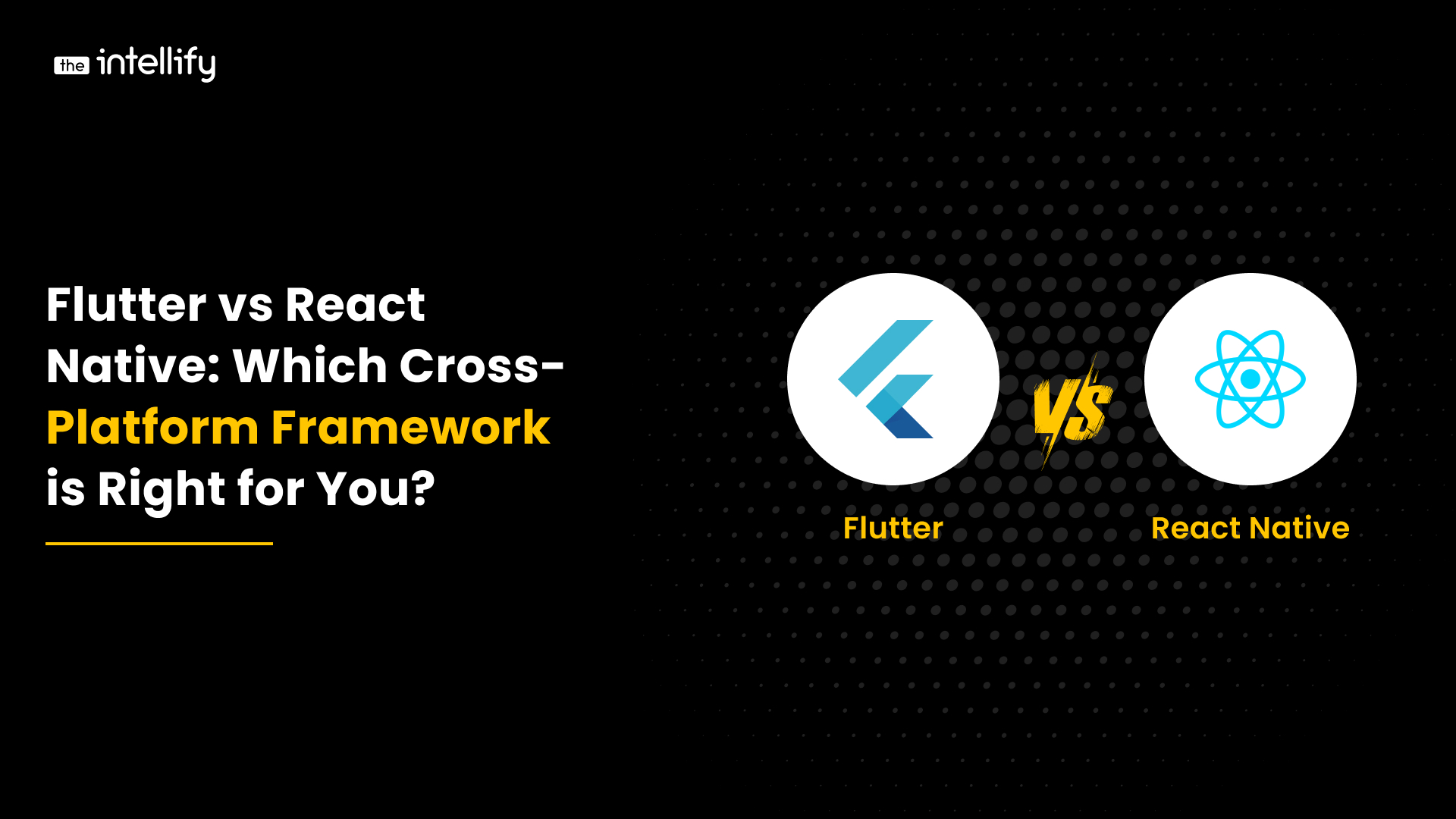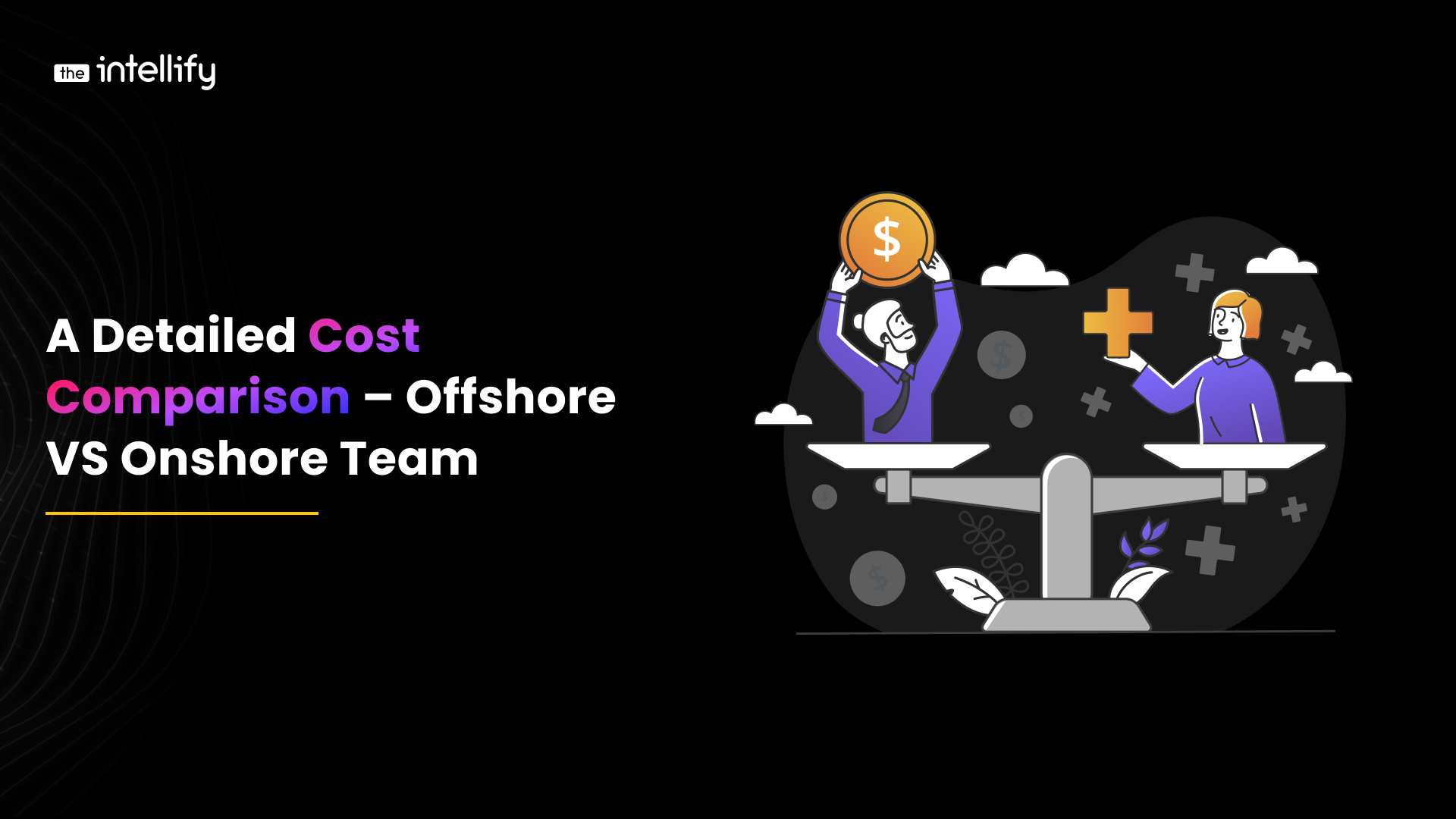Flutter vs React Native: Which Cross-Platform Framework is Right for You?

By Darshak Doshi
May 27, 2024

Choosing the right cross-platform framework for mobile app development is crucial to your project’s success. Among the most popular and robust options available today are Flutter and React Native. Both frameworks promise to streamline development and reduce costs. And deliver high-quality applications across many platforms. Yet, each has unique strengths, weaknesses, and specific use cases that can make one a better fit, depending on your project’s needs.
This blog will explore Flutter and React Native, comparing their performance, development experience, community support, and more. Whether you’re a developer trying to decide which framework to invest in or a business looking to choose the best technology for your next big app, this blog will help you make an informed decision.
Let’s explore the features, benefits, and potential drawbacks of Flutter and React Native to determine which cross-platform framework is right for you.
React Native: What is it?
Facebook developed the React Native framework, which enables programmers to create mobile apps using JavaScript and React. When released in 2015, developers could use the same code to create Android and iOS app development, leading to its rapid popularity. As a result, you may save time and effort by not having to build unique code for every platform.
React Native’s use of native components the application interface is composed of real native elements is one of its main advantages. As a result, the app has a more genuine appearance and feels reminiscent of apps created especially for each platform. Hot reloading, another characteristic of React Native, speeds up development by enabling developers to view changes without restarting the application. It is also accessible to web developers familiar with JavaScript and React because it uses these technologies. Finding answers and sharing information is simpler when there is a wide ecosystem and strong community support.
Flutter: What is it?
Google created the Flutter toolkit, which enables developers to create built desktop, web, and mobile applications from a single codebase. It was released in 2017 to streamline the development process by allowing programmers to develop code only once. And distribute it across several platforms, such as desktop, web, iOS, and Android.
Flutter uses the Google-created Dart programming language, which is renowned for its simplicity and efficiency. A notable characteristic of Flutter is its extensive collection of customizable widgets. Which simplifies establishing a unified design across several platforms. Additionally, Flutter has a hot reload. Which helps speed up development by letting developers see the effects of their changes immediately. Flutter produces functioning, high-performance apps by compiling native code.
Similarities Between Flutter and React Native
When comparing React Native with Flutter, it’s important to note that both are open-source tools for creating cross-platform mobile apps and share capabilities like hot reload, or what React Native developers call live reload. What is meant by that? Thanks to hot reload, developers may view the code changes without reloading the application. It enables simpler problem fixes and quicker coding and development.
React Native and Flutter both ease the idea of having a single codebase across Android and iOS, meaning that users of each platform may access identical apps. Additionally, this coding eliminates the need for testing. The ease of developing fewer tests for various mobile devices is the reason.
About Flutter vs. React Native’s presence, both frameworks power several well-known applications. Flutter’s development is responsible for the success of the Google Ads app, the Hamilton Broadway musical app, and Alibaba’s Xianyu. At the same time, React Native is responsible for many more applications, including Facebook, Pinterest, and Instagram.
Simplicity of Learning
Developers must decide which language to learn—Flutter or React Native—when weighing these two options.
From the developer’s perspective, React Native is simpler to understand. And there’s a good reason: JavaScript is the programming language it employs. Since JavaScript has been around for a long time, most developers know it. Many extend the learning graph, while Flutter uses Dart, a younger language. That still needs to imply that Dart makes Flutter a challenging framework. Instead, it’s a single feature that sets Google’s platform apart. You will discover how soon enough.
Documentation Support
Given that Google supports Flutter, one might expect much more extensive documentation. It is! Cross-platform development professionals may find the more in-depth. And educational information provided by the Flutter framework is a valuable resource. React Native keeps the material less focused and more generalist. Even though it doesn’t lag in documentation support. Furthermore, the method by which the developers are provided with the React Native app development instructions is a little disjointed.
Community Assistance
Many developers can enjoy the help of the worldwide development community while pursuing cross-platform development. React Native should have a large online community supporting it, as it was released far earlier than Flutter. Solutions to your problems and challenges when designing an app are available.
That said, Flutter is a rising star with an ever-expanding developer community. And 2020 is predicted to be a big year for the company. So, Flutter’s lower degree of community support maturity shouldn’t be a major deterrent.
Third-party Libraries vs. Widgets
One of their main differences is the degree to which the two frameworks rely on third-party libraries. Google created Flutter, which comes with a ton of amazing widgets. And tools that let developers of mobile applications create UIs that are the same for iOS and Android app development. React Native requires developers to use third-party libraries. The recognition speeds up development for Flutter developers.
The difference also affects how testing is carried out when creating apps with the two frameworks. While React Native developers must once more rely on third-party solutions for testing, Flutter developers find that the widget testing support makes their process easier and faster.
Performance
Every framework should consider performance. JavaScript-based frameworks eliminate performance causes. Some JavaScript web development frameworks, like TezJS, optimize Core Web Vitals with unmatched hyperspeed, even on mobile devices. Yet others still need to provide improved performance.
When comparing the speed of React Native vs Flutter, React Native runs hybrid apps for several mobile platforms using JavaScript bridges or layers. It removes this extra layer because Flutter app development USA allows developers to reuse existing code without requiring JavaScript bridges.
Unlike React Native, which references the JavaScript layer during compilation, Flutter compiles to the native code. This is one of the few features that set Flutter apart from other cross-platform application development frameworks, like React Native.
Difference Between React Native and Flutter
Understanding each framework’s main differences and advantages is critical when choosing between Flutter and React Native for your cross-platform app development demands. Both Flutter and React Native are strong tools with distinct benefits. But which one is best for you will depend on your project’s needs and development preferences.
Compatibility
Flutter is compatible with iOS 8 or later devices and Android 4.1 (Jelly Bean) and is available on many platforms. React Native works with iOS 10 or later and Android 4.1 (Jelly Bean).
Performance
By eliminating the need to bridge between the device’s operating system. And the application, Flutter converts the Dart language straight into native ARM code. This direct compilation may improve performance, especially when speed is essential. React Native uses a bridge to communicate with native components while running JavaScript code in a virtual machine on the device, which may result in some performance overhead.
Experience with Development
Flutter uses Dart, a Google-developed language that is simple to learn and well-suited for UI development. Yet, because React Native uses JavaScript and JSX, web developers familiar with these technologies will find them easier to use.
The Ecosystem and Community
With a sizable community and broad Facebook backing, React Native has access to many libraries and collective expertise. Even though Flutter is more recent, it is expanding, supported by Google, and has a growing community and resource base.
React Native or Flutter – Which is better?
The decision between Flutter or React Native comes from your project’s requirements and your development team’s expertise. High speed is promised by Flutter, which runs on Dart; even so, it should be noted that Dart isn’t as popular as JavaScript, which is what React Native uses. Although Flutter could provide faster compilation, its lesser adoption rate may imply that developers must be more experienced. So, IDE support may be more constrained. Though it might lead to greater file sizes, Flutter does include integrated testing capabilities that help speed up the testing process.
Yet, React Native’s use of JavaScript results in a larger development community and more support. Knowing JavaScript helps hurry development because engineers are already familiar with the language. React Native could perform worse than Flutter due to its dependency on JavaScript bridging. React Native testing usually necessitates third-party frameworks like Detox. Even so, because of its extensive use and active community. You may discover a wealth of information and answers to asked questions.
Finally, the decision between React Native or Flutter is based on your project’s unique requirements and the abilities of your development team. The Intellify has a vast and experienced development team to help you decide which platform suits your app development. Flutter may be the best option for apps where performance and integrated testing are essential. Yet, React Native can be a better option if you value a bigger developer community and quicker development using a well-known language.
Conclusion
With their advantages and disadvantages, Flutter and React Native provide strong options for developing cross-platform mobile apps. Flutter excels in speed and integrated testing features because of its Dart language and direct compilation to native code. Yet, because JavaScript is more used, React Native’s usage allows for speedier development and a larger developer base.
When deciding between Flutter and React Native, it’s crucial to consider aspects like project objectives, development partner expertise, performance requirements, and community support. While React Native could be a better fit for projects prioritizing a bigger developer community. And speedier development with a known language, Flutter might be better for those requiring excellent performance and integrated testing.
Yet, the project’s unique requirements and the development team’s strengths should be considered when making the ultimate selection. If you are looking for a leading app development company, look at The Intellify.
FAQs
1. Is Flutter Or React Native Simpler To Learn?
Since many developers are familiar with JavaScript, React Native is considered easier to learn. Developers unfamiliar with Dart may need to familiarize themselves before working with Flutter.
2. Flutter Vs React Native: Which Framework Provides More Documentation Support?
With Google’s help, Flutter provides extensive documentation support and in-depth material. While documentation is also available for React Native, it is less specific and broader than Flutter’s.
3. Flutter Vs React Native: Which Framework Is More Supported By The Community?
Because React Native is more established and has been around longer, it has a larger and more experienced developer community that provides tools and assistance. Nonetheless, the Flutter community is expanding and is anticipated to grow further.
4. Which Offers Superior Performance, Flutter Or React Native?
Flutter’s performance is higher since it compiles with native code. Even while React Native is fast, its JavaScript bridge may cause some performance penalties.
5. Is Flutter Or React Native A Superior Framework For Testing?
Flutter’s integrated testing tools simplify and ease testing. Testing React Native usually requires external testing frameworks such as Detox.

Written By, Darshak Doshi
The CTO and Co-Founder of The Intellify. Darshak thrives on exploring innovative techniques and strategies. His insightful posts are a valuable resource for businesses seeking fresh development ideas.


Real Estate Mobile App Development 101: All You Need to Know
Today, the real estate industry is improving with the help of new technology. Mobile applications are one of the major aspects of this shift. Real estate mobile app development has become crucial for such businesses, which must remain relevant. The applications benefit buyers, sellers, agents, and property managers. In the contemporary world, individuals desire convenience […]


How Much Does It Cost to Build a Marketplace App Like Gumtree?
Detail Guide About Digital Marketplace like Gumtree The world is shifting online. Marketplace apps have emerged as major contenders. They bring buyers and sellers closer than ever. These platforms have cut the method of buying and selling. They have also fostered the market for both people and companies. Of all the marketplace apps, Gumtree is […]


Top 10 Healthcare Business Ideas to Boost Your Startup Success
Innovative Opportunities for Startups in Healthcare Startups find the healthcare sector promising. This is because demand for better and more accessible healthcare is growing. New technologies, like telemedicine and wearable health devices, create innovation opportunities. They also create chances for improvement in patient care. Blockchain technology can also enhance data security and streamline healthcare processes. […]


How Much Does It Cost to Build a Healthcare App Like Patient Access?
Costs of Developing Healthcare Apps In the quickly changing landscape of digital healthcare, patient-centric apps like Patient Access have emerged as critical tools for improving patient care and expediting medical procedures. These apps let users arrange appointments, access their medical information, manage medications, and contact healthcare providers from the comfort of their own homes. The […]


A Detailed Cost Comparison Offshore VS Onshore Teams
Detailed Cost Comparison Offshore VS Onshore Teams The world is always changing due to globalization. The choice between offshore vs onshore outsourcing teams is crucial for companies. Thanks to globalization, which erases boundaries. Organizations can depend on a vast talent pool worldwide. This has led to offshore outsourcing. In it, a team from another country, […]


Real Estate Mobile App Development 101: All You Need to Know
Today, the real estate industry is improving with the help of new technology. Mobile applications are one of the major aspects of this shift. Real estate mobile app development has become crucial for such businesses, which must remain relevant. The applications benefit buyers, sellers, agents, and property managers. In the contemporary world, individuals desire convenience […]

0
+0
+0
+0
+
Committed Delivery Leads To Client Satisfaction
Client Testimonials that keep our expert's spirits highly motivated to deliver extraordinary solutions.

Let’s start a Conversation about your Business Goals!
Drop us a line to Start a Project with us
Contacts For Business
Contacts For Career












